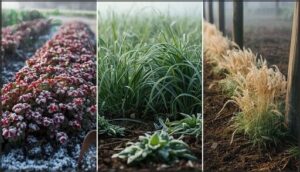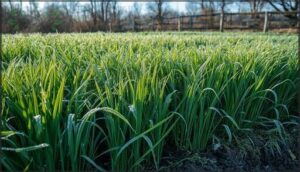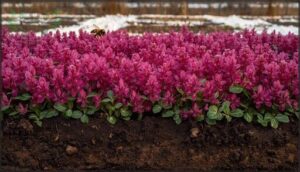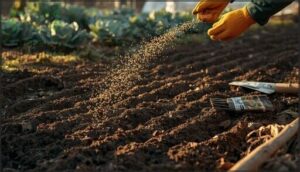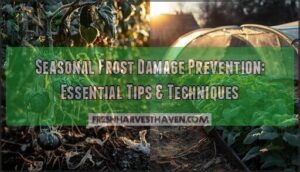This site is supported by our readers. We may earn a commission, at no cost to you, if you purchase through links.

Your garden soil doesn’t take a vacation when winter arrives—it either improves or deteriorates based on what you do right now. Bare soil exposed to harsh weather loses nutrients, compacts under heavy rain, and becomes a breeding ground for weeds come spring.
Winter garden cover crop options offer a practical solution, acting as a protective blanket that works around the clock to build soil health while you’re inside staying warm. These hardy plants prevent erosion, fix nitrogen, suppress weeds, and add organic matter without requiring constant attention.
The right cover crop transforms your winter garden from a dormant liability into an active soil-building asset, setting you up for a stronger growing season ahead.
Table Of Contents
- Key Takeaways
- Top Benefits of Winter Cover Crops
- Choosing The Right Winter Cover Crop
- Best Winter-Hardy Cover Crop Options
- Winter-Killed Cover Crops for Easy Management
- Planting and Establishing Winter Cover Crops
- Managing and Terminating Cover Crops in Spring
- Frequently Asked Questions (FAQs)
- What is the best cover crop for a garden in winter?
- What is the fastest growing winter cover crop?
- What to cover a garden with in winter?
- How late can you plant winter cover crops?
- What crops can you grow in the winter in your garden?
- What happens if cover crops freeze completely?
- Can cover crops attract harmful garden pests?
- Do cover crops compete with nearby perennials?
- How much do winter cover crop seeds cost?
- When should cover crops be terminated in spring?
- Conclusion
Key Takeaways
- Winter cover crops prevent soil erosion by 40-90%, suppress weeds by 60-96%, and boost organic matter by 8-114% while you’re off-season, transforming dormant beds into active soil-building systems.
- Legumes like hairy vetch and Austrian winter pea fix 50-200 kg of nitrogen per hectare annually, potentially cutting your fertilizer costs in half while feeding beneficial microbes that improve nutrient cycling.
- Match your cover crop to your biggest challenge—winter rye excels at weed suppression and survives to -30°F, while oilseed radish taproots break up compacted clay and increase root penetration fourfold.
- Terminate cover crops 2-3 weeks before spring planting to allow proper decomposition, and rotate species yearly (rye, vetch mixes, clover, then oats) to build soil carbon by 6-8% and create long-term resilience.
Top Benefits of Winter Cover Crops
Winter cover crops do more than just sit there looking green—they’re working hard beneath the surface to transform your garden soil. From stopping erosion to feeding beneficial microbes, these crops tackle problems that would otherwise cost you time and money come spring.
Here’s what you can expect when you put cover crops to work in your winter garden.
Preventing Soil Erosion
When winter rains pound bare ground, soil washes away fast—but winter cover crops act like a protective blanket, stopping erosion in its tracks. Studies show cover crops can slash sediment loss by 40% to 90%, and they cut runoff by delaying overland flow.
Grass and legume mixtures offer especially strong winter protection, holding soil particles in place through freeze-thaw cycles and spring storms. They also improve soil structure by rooting into the soil.
Improving Soil Health and Fertility
Beyond stopping erosion, cover crops rebuild your soil from the inside out. Legumes pull nitrogen from the air and pack it into roots and shoots—research shows they can fix 50 to 200 kg per hectare each year.
As cover crops break down, they boost organic matter by 8% to 114%, feeding soil microbes and improving nutrient cycling so your spring vegetables get a fertility head start. Cover crops also protect the soil surface, increasing soil organic matter.
Suppressing Weeds Naturally
Soil fertility improvements naturally lead to cleaner beds. Winter cover crops crowd out weeds before they start, cutting weed biomass by 60% to 96% when residues provide dense groundcover. Cereal-legume mixes work especially well—rolled rye and vetch hold back weeds for 8 to 10 weeks after termination. Allelopathic effects from decomposing rye also block small-seeded weeds from germinating.
Four ways cover crops suppress weeds naturally:
- Dense canopy: Living mulches and high-biomass cover crops shade out weed seedlings before they establish.
- Physical barrier: Thick residue mulches cover bare soil, blocking light and limiting weed emergence.
- Chemical inhibition: Allelopathic compounds from cereal rye continue suppressing germination weeks after termination.
- Early competition: Fast-growing cereal-legume mixes outcompete weeds for water, nutrients, and space during establishment.
Enhancing Spring Soil Preparation
Cover crops make your spring work easier. Residue contributions from winter rye or vetch improve seedbed quality by reducing clods and boosting soil structure—some trials show less tractor fuel use per acre.
Moisture management and nutrient cycling mean fewer fertilizer inputs, while termination timing protects planting windows.
Reduced-tillage seedbeds become workable faster, letting you prep early spring cover crop areas and plant on schedule without fighting compacted ground.
Supporting Beneficial Soil Life
Beneath your garden’s surface, cover crops fuel a hidden ecosystem. They boost microbial biomass by up to 27%, while mycorrhizal fungi thrive on living roots and residue habitat.
Earthworms multiply—some plots gain hundreds more per square meter—mixing organic matter deep into your soil.
Enhanced nutrient cycling and stable soil fauna mean healthier crops later, turning your winter cover into a living investment in soil improvement techniques.
Choosing The Right Winter Cover Crop
Picking the right winter cover crop isn’t a one-size-fits-all decision. Your climate, soil conditions, and what you want to accomplish in your garden all play a role in making the best choice.
Let’s look at the key factors that’ll help you match the perfect cover crop to your specific needs.
Assessing Climate and Hardiness Zones
Your growing zone tells you which winter cover crops will survive the cold and which will winterkill by spring. Check the USDA hardiness map—updated with 1991–2020 data—to find your zone temperature averages and freeze risk dates. Then match species cold tolerance to your conditions:
- Winter hardy crops like hairy vetch thrive in zones 3–7
- Winterkilled cover crops such as oats die after frost
- Microclimate considerations and changing zone maps affect species selection
Considering Soil Type and Needs
Your soil type determines which winter cover crops will thrive and deliver results. Sandy soil drains quickly but loses nutrients; hairy vetch and other legumes improve moisture retention and add organic matter. Clay soil holds water and compacts easily; cereal rye’s deep roots break up hardpan and boost porosity. If you’re dealing with waterlogging, Persian clover tolerates wet conditions that stress other species. For soil pH between 5.5 and 9, Persian clover adapts without extra amendments. Tackle soil compaction with rye’s fibrous root system—studies show cover crops cut bulk density by roughly 31 percent where compaction exists. Match your choice to your soil’s specific challenges for better soil health.
| Soil Challenge | Recommended Winter Cover Crops |
|---|---|
| Sandy, low organic matter | Hairy vetch, legume mixes |
| Heavy clay, compaction | Cereal rye, winter wheat |
| Wet, poorly drained | Persian clover, hairy vetch |
Selecting for Nitrogen Fixation
When you want to slash fertilizer bills and build soil fertility, nitrogen-fixing legumes are your workhorse winter cover crops. Hairy vetch and Austrian winter pea commonly fix 90–200 kg nitrogen per hectare when allowed full spring growth before termination timing. Rhizobia inoculation secures nodulation in soils without recent legume history, securing nitrogen credits that can reduce synthetic inputs by nearly half. Legume mixtures with grasses slow nitrogen release but improve biomass accumulation and erosion control.
- Hairy vetch delivers the highest nitrogen fixation among cool-season legumes, releasing up to 80% of accumulated nitrogen within five weeks after termination.
- Austrian winter pea ranks close behind in performance, fixing over 150 kg nitrogen per hectare under favorable conditions with minimal fertilizer needs.
- Mixed stands like clover–vetch blends usually provide 50–85 kg nitrogen per hectare to your next crop when managed for best biomass.
Matching Cover Crops to Garden Goals
Think of cover crop selection as picking the right tool for the job—each species solves a specific problem in your winter garden. Match your choice to your toughest challenge, whether that’s erosion, weeds, or compacted clay. Space management matters too; shallow beds need shallow roots, while deep plots can handle taproots that break hardpan.
| Primary Goal | Recommended Species |
|---|---|
| Erosion prevention and soil cover | Winter rye, oats, wheat |
| Weed control and suppression | Winter rye, sorghum-sudangrass |
| Soil structure and compaction relief | Radish, mustard, deep-rooted brassicas |
| Climate alignment and winter hardiness | Match hardiness zone to species tolerance |
NRCS standards remind you to avoid species that harbor pests threatening your spring crops. Johnny’s Selected Seeds advises aligning planting cover crops with your exact timeline—when you’ll terminate and when vegetables go in.
Small raised beds demand fast growers like oats or crimson clover that won’t overwhelm limited space, while larger plots benefit from diverse mixes combining grasses and legumes for multiple soil health benefits across the fallow season.
Best Winter-Hardy Cover Crop Options
When you need cover crops that can handle frost, snow, and freezing temperatures, you’ve got several reliable choices that will keep working through winter. These hardy plants stay alive even when things get cold, protecting your soil and building fertility until spring arrives.
Let’s look at the top winter-hardy options that can transform your garden beds during the off-season.
Winter Rye for Weed Suppression
If you’re battling stubborn weeds season after season, winter rye could be your best ally. This powerhouse cover crop stands up to extreme cold—surviving down to -30°F—and grows thick enough to crowd out unwanted plants through allelopathic effects that slow weed germination.
Here’s what makes it ideal for weed control:
- Creates dense rye biomass that blocks light and space
- Offers suppression duration that extends into early spring
- Requires proper planting density for maximum effectiveness
Hairy Vetch for Nitrogen Fixing
While winter rye combats weeds, hairy vetch addresses nitrogen. This legume fixes atmospheric nitrogen into your soil, delivering 105–113 pounds per acre in pure stands. Plant 25–30 pounds per acre in fall, and it’ll overwinter where other clovers fail, then explode with spring growth.
| Feature | Monoculture | Mixed with Rye |
|---|---|---|
| Nitrogen Production | 105–113 lb/acre | ~79 lb/acre |
| Fall Growth Pattern | Slow establishment | Enhanced biomass |
| Spring Vigor | Maximum N fixation | Balanced cover |
| Management Ease | Simple termination | Better weed control |
| Hard Seed Risk | 10–20% volunteers | Cereal dilutes stand |
Watch for volunteer plants if you let it set seed—that 10–20% hard seed can surprise you next season.
Crimson Clover for Soil Enrichment
Crimson clover suits milder regions where hairy vetch might be overkill. This hardy legume adds nitrogen to your soil and crimps easily for no-till systems, leaving surface mulch that keeps spring moisture in place.
Its early blooms feed pollinators before you plant vegetables.
Mix it with rye and hairy vetch to diversify root depth and nitrogen contribution, but expect winter-kill if temperatures drop into the mid-20s °F.
Winter Wheat and Barley Benefits
Winter wheat and barley grow more slowly than rye, giving you extra breathing room before spring termination. They won’t turn into weeds in your next crop, and barley tolerates hot fall weather better than most small grains.
Both small grains build organic matter, protect against erosion, and boost soil health without the aggressive spring growth that complicates planting schedules.
Winter-Killed Cover Crops for Easy Management
If you’re not looking to manage spring growth, winter-killed cover crops might be your best bet. These varieties die off naturally during hard freezes, leaving behind organic matter that breaks down into your soil without any extra work.
You’ll find options that protect soil through winter and set you up for easier spring planting with minimal effort.
Oats for Quick Growth and Erosion Control
Oats offer gardeners one of the simplest solutions for winter cover crops, especially if you’re looking for quick establishment and erosion control. They grow rapidly in fall, creating dense canopy cover up to 83% before frost arrives, which shields your soil from wind and rain.
These plants produce between 3,871 and 5,667 pounds of oat biomass per acre before winter-kill, forming excellent surface protection. Their fast growth also crowds out winter weeds, and when spring arrives, you’ll find the dead residue easy to work into your soil with minimal tillage.
Field Peas for Organic Matter
Field peas bring a double advantage to your winter garden, combining nitrogen-fixing power with substantial organic matter. When mixed with oats, these nitrogen-fixing cover crops winter-kill in regions colder than Zone 7, leaving behind residue that enriches your soil structure.
The pea biomass decomposes through winter, releasing biologically fixed nitrogen at a steady rate. This planting mixture captures nutrients while building organic matter, and the decomposition rate ensures your spring soil receives both carbon and nitrogen contributions right when your vegetables need them most.
Buckwheat for Pollinator Support
Although buckwheat often functions as summer cover crops, you can plant it as a late-season option before autumn’s first frost kills it at 0 to -2 °C. The buckwheat bloom time attracts honeybees and beneficial insects, supporting pollinator diversity while you’re building soil.
This winter-killed crop eliminates mechanical termination needs, and you’ll find seed sources readily available for quick establishment in your garden rotation.
Radish and Mustard for Soil Loosening
For compacted vegetable beds, oilseed radish and mustard deliver powerful biodrilling action through their deep taproots. Radish roots increase subsequent crop root penetration through hard layers by up to fourfold, while mustard glucosinolates suppress soil pests as residues break down.
These winter-killed cover crops offer practical compaction reduction:
- Radish taproots penetrate dense subsoil layers
- Mustard varieties produce erosion-controlling biomass before winter
- Both winter-kill reliably in northern zones
- Residue breakdown releases captured nutrients by spring
Planting and Establishing Winter Cover Crops
Getting your winter cover crops in the ground at the right time makes all the difference between a thriving stand and a patchy disappointment. The window for planting varies depending on where you garden, but there are some reliable techniques that work across different climates and garden setups.
Here’s what you need to know about timing, soil prep, seeding methods, and making cover crops work in smaller spaces.
Ideal Planting Windows and Schedules
Timing cover crops right makes all the difference. For winter-hardy species like cereal rye, plant 30 to 40 days before your first hard frost—that’s mid-August through September for most northern zones. Winter-killed species such as oats need planting by early September to establish well.
Here’s a quick zone-based timing guide:
| USDA Zone | Fall Planting Window |
|---|---|
| Zone 4–5 | July 15–September 10 |
| Zone 6–7 | August 10–October 1 |
Match your vegetable crop schedule to your cover crop planting, especially for beds you’ll plant early next spring.
Soil Preparation Techniques
You don’t need deep tilling to prep for cover crops—light surface work does the job. Loosen the top two to three inches with a rake or broadfork, which improves drainage without disrupting soil organic matter layers.
If your pH is off, spread lime or sulfur now. Tilling alternatives like shallow cultivation protect beneficial microbes while still giving winter rye or other cover crops the contact they need to germinate.
Seeding Methods and Inoculant Use
Your seeding strategies shape how well your cover crop takes off. Drills give you precision and let you cut seed use by 10 to 50 percent compared to broadcast methods, while broadcasting needs 20 to 50 percent more seed to compensate for uneven coverage.
When planting legumes, coat seeds with inoculant using a slurry—mix 8 to 10 ounces of liquid per 50 pounds—and plant within 24 hours for best nodulation.
Tips for Raised Beds and Small Gardens
Raised beds call for smart space optimization—plant cover crops across the entire surface, not just in rows. Species mixes like clover with rye optimize soil protection and nutrient cycling.
In a 4-by-8-foot bed, broadcast 20 to 30 grams of seed per square meter for full winter cover. Dense planting suppresses weeds, and manual termination methods work perfectly at this scale.
Managing and Terminating Cover Crops in Spring
When spring arrives, your cover crops have done their job, and it’s time to convert them back into the soil or use them as mulch. The way you terminate and manage these plants can make or break your garden’s success for the season ahead.
Here’s how to handle your cover crops so you can plant vegetables at just the right time while building soil health for years to come.
Mowing and Mulching Strategies
Mowing at or just before full bloom slows decomposition dynamics and extends mulch persistence for stronger weed suppression through spring. Mulch thickness matters—dense, layered residues keep soil moisture higher and block emerging weeds more effectively than thin cover crop residue.
For small-scale practices, mowing and tarping together can terminate young stands in about 30 days, creating a ready-to-plant surface with minimal fuss.
Incorporating Cover Crops Into Soil
If you prefer to work residues directly into soil, tillage systems can accelerate decomposition rates and nutrient release. Turning cover crops under mixes organic matter into the top few inches, feeding soil organisms and building soil health.
Just remember to wait two to three weeks after incorporating winter cover crops before planting—this planting delay lets breakdown proceed and prevents nitrogen tie-up in your spring beds.
Timing for Planting Spring Vegetables
Once you’ve managed termination methods and residue management, garden planning shifts to aligning planting schedules with soil conditions. Cool-season crops like peas tolerate soil temperatures around 40°F, but warm-season vegetables need 60°F or warmer. Here’s your spring timeline after winter cover crops:
- Wait 7-14 days after termination before planting
- Check moisture levels to avoid competition stress
- Monitor soil temperature daily with a thermometer
- Match crop rotation to your cover crop’s nitrogen release
Rotating Cover Crops for Long-Term Soil Health
Beyond single-season use, crop rotation unlocks cover crops’ full potential. Alternating winter rye, hairy vetch, and crimson clover builds organic matter and improves nitrogen cycling, while diverse sequences boost weed suppression by up to 49% over time.
Here’s your rotation framework:
| Year | Winter Cover Crop |
|---|---|
| Year 1 | Winter rye |
| Year 2 | Hairy vetch + rye mix |
| Year 3 | Crimson clover |
| Year 4 | Oats and field peas |
Multi-year rotations increase soil carbon by 6-8%, improve yield stability, and strengthen soil biology—turning your garden into a self-improving system that rewards patience with resilience.
Multi-year cover crop rotations turn your garden into a self-improving system that builds carbon, stabilizes yields, and strengthens soil biology with every season
Frequently Asked Questions (FAQs)
What is the best cover crop for a garden in winter?
The “best” option isn’t one-size-fits-all—your garden size, soil needs, and climate impact matter most. Winter rye excels at weed control, while hairy vetch delivers nitrogen.
Consider crop rotation and budget concerns when choosing winter cover crops.
What is the fastest growing winter cover crop?
Oats stand out as the fastest growing winter cover crops, germinating in just 5 to 7 days and producing substantial fall biomass quickly. They winterkill reliably, simplifying spring management without intensive termination.
What to cover a garden with in winter?
Your garden needs protection when frost arrives. Winter cover crops like hairy vetch or winter rye work beautifully, while leaf blankets, compost blankets, or winter mulching also shield soil from harsh cold frame covers conditions.
How late can you plant winter cover crops?
You can plant winter hardy crops like rye until late October in warmer growing zones, though earlier seeding produces better biomass.
Winter killed crops need at least four weeks before frost to establish properly.
What crops can you grow in the winter in your garden?
Like a living blanket, winter hardy crops such as winter rye, hairy vetch, and crimson clover thrive in cold-season gardens.
These edible winter crops and cover crop selections protect soil while providing nitrogen, erosion control, and organic matter.
What happens if cover crops freeze completely?
When frost kills cover crops completely, erosion control weakens and nutrient leaching increases as residues decompose quickly.
Winter-killed species still improve soil structure through root channels, though weed suppression diminishes faster than with winter-hardy alternatives.
Can cover crops attract harmful garden pests?
Yes, certain cover crops can increase slug populations and seedcorn maggot risk, particularly brassicas like radish. However, termination timing impacts pest attraction, while simultaneously boosting beneficial insects that help with weed suppression throughout your winter garden.
Do cover crops compete with nearby perennials?
Cover crops can compete with perennials through water competition, nutrient depletion, and root interference. Dense covers may reduce growth by 10–40% if planted too close, though proper spacing and timely termination minimize these effects.
How much do winter cover crop seeds cost?
You might think cover crop seeds break the bank, but seed packet prices start around $5 for small gardens.
Cost per pound and per-acre costs vary by species, making budget considerations straightforward for most growers.
When should cover crops be terminated in spring?
Your spring management considerations should align termination timing with vegetable planting schedules—usually three weeks before seeding small crops. This interval allows biomass accumulation to break down, promoting nitrogen release and improved soil tilth for your garden.
Conclusion
What will your soil look like when spring arrives—exhausted and compacted, or rich with life? Your choice of winter garden cover crop options determines that outcome.
These plants work silently through cold months, building fertility while you plan next season’s harvests. Start with one bed this year, observe the difference, and expand from there.
The investment is minimal, but the returns compound with every growing season. Your future garden begins with what you plant today.
- https://content.ces.ncsu.edu/winter-annual-cover-crops
- https://growiwm.org/mix-cereal-rye-with-hairy-vetch-to-cash-in-on-cover-crop-benefits/
- https://www.sare.org/resources/cover-crops/
- https://www.farmers.gov/blog/cover-crops-benefit-both-commercial-farmers-and-urban-gardeners
- https://extension.illinois.edu/blogs/flowers-fruits-and-frass/2023-08-04-harness-power-nature-winter-kill-cover-crops

